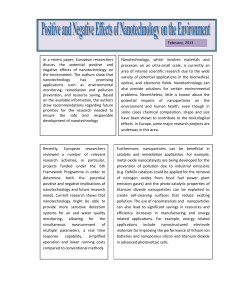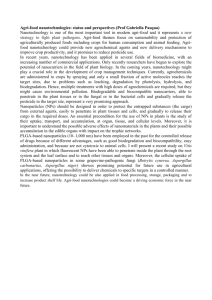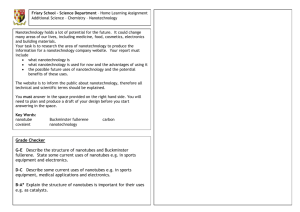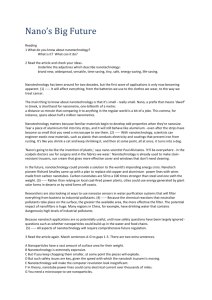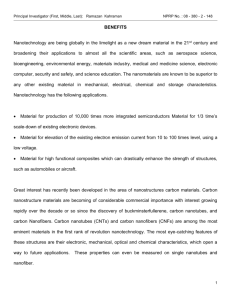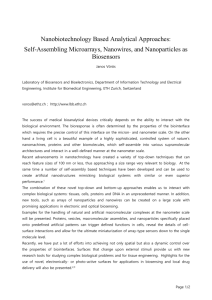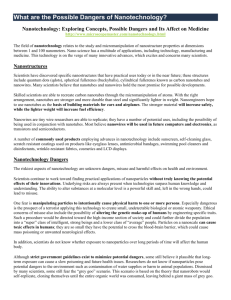Induction to Phys6014 course - Laboratory for Inorganic Colloidal
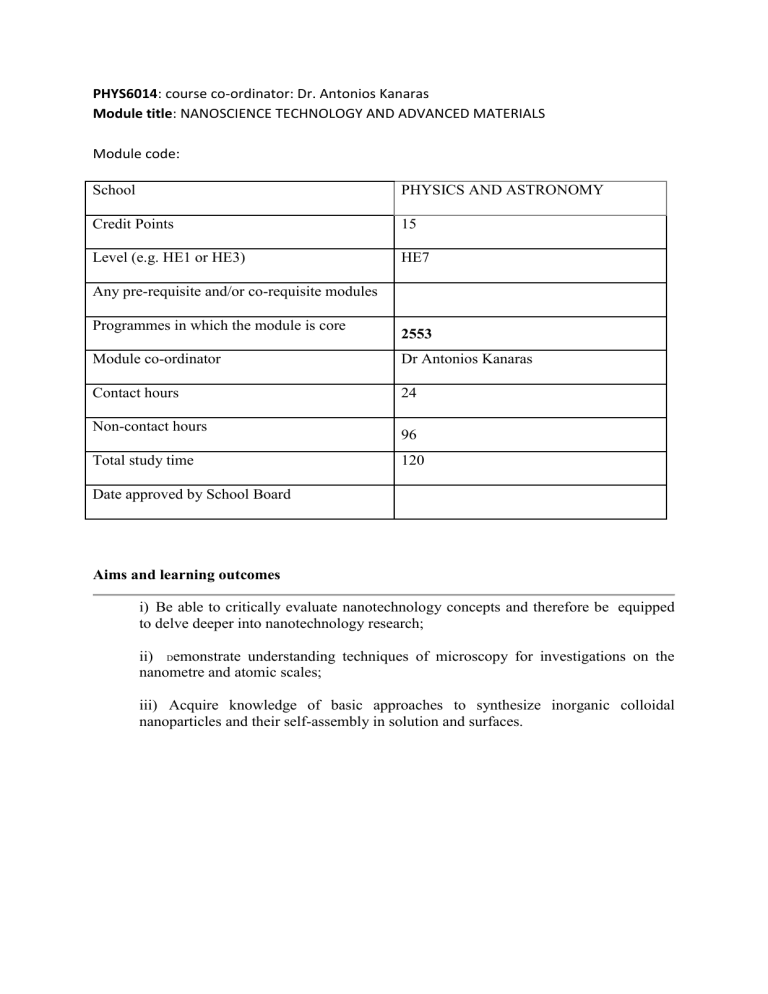
PHYS6014: course co-ordinator: Dr. Antonios Kanaras
Module title: NANOSCIENCE TECHNOLOGY AND ADVANCED MATERIALS
Module code:
School PHYSICS AND ASTRONOMY
Credit Points
Level (e.g. HE1 or HE3)
15
HE7
Any pre-requisite and/or co-requisite modules
Programmes in which the module is core
Module co-ordinator
2553
Dr Antonios Kanaras
24 Contact hours
Non-contact hours
Total study time
Date approved by School Board
96
120
Aims and learning outcomes i) Be able to critically evaluate nanotechnology concepts and therefore be equipped to delve deeper into nanotechnology research; ii)
D emonstrate understanding techniques of microscopy for investigations on the nanometre and atomic scales; iii) Acquire knowledge of basic approaches to synthesize inorganic colloidal nanoparticles and their self-assembly in solution and surfaces.
Summary of syllabus content
The aim of this course is to provide students with a background in nanotechnology by focusing on selected research topic within this area. This will provide students with a basic knowledge and grounding in cutting edge research being undertaken within this field. Nano science deals with the exploration and application of physical phenomena in matter structured or patterned on a nanometer scale. This scale corresponds to the wavelength of electrons and photons.
This is an interdisciplinary course provided by the Schools of Chemistry (HE3) and Physics
(HE4).
Lecture Content
Introduction to nanotechnology: Moore’s law, silicon microfabrication techniques such as photolithography/electron beam lithography and their advantages and limitations, importance of nanotechnology and its potential impacts, historical milestones in nanotechnology, pre-requisites to make transition into nanotechnology era, nanotechnology products.
Colloidal nanoparticles: Metal nanoparticles, semiconductor nanoparticles, metal oxide nanoparticles, fundamentals of nucleation, influence of ligands in the crystal growth and colloids stabilization, synthesis of anisotropic nanocrystals.
Self assembly of nanomaterials: Layer by Layer assembly, block copolymers, selfassembled monolayers, ionic self-assembly, DNA based self-assembly. Selfassembly of inorganic nanospheres and anisotropic particles, suplerlattices, tip to tip assembly.
Scanning Probe Microscopies: Operating principle of Scanning Tunnelling
Microscope (STM), tunnelling through a rectangular 1-D barrier with definition of tunnelling probability, modes of operation (constant current and constant height imaging), advantages and disadvantages of STM, STM imaging of metals and semiconductor surfaces with examples, tunnelling spectroscopy, quantum corral as an example for particle in a 2-D circular box.
Atomic Force Microscope (AFM): operating principle, different techniques such as contact, tapping, lateral and phase-sensitive mode and their strengths and weaknesses, limitations of current probe design and how these can be overcome by carbon nanotube (CNT) modified probes, fabrication methods of CNT probes and their application with examples.
Scanning Near Field Optical Microscope (SNOM): operating principle, instrumentation, different modes of operation, application of SNOM for single molecule detection.
Single-electron transistor: Coulomb blockade effect, Transport properties in nanostructures
Electron microscopies: Scanning Electron Microscopy (SEM) and Transmission
Electron Microscopy (TEM): operating principle, strengths and weaknesses of each technique, application to the characterisation of nanostructured materials as an example.
Carbon nanotubes: discovery of nanotubes, types of carbon nanotubes, fabrication methods, carbon nanotube FET, STM studies on carbon nanotubes, mechanical, physical and chemical properties with examples.
Quantum dots, wells and wires: Definition, fabrication, physical properties
Summary of teaching and learning methods
The course will consist of 20 lectures plus the equivalent of four lectures for independent study. Students will be given non-assessed problems sheets and are expected to solve these in their own time. They will also be given some directed reading.
The course materials will be accessible online in http://www.licn.phys.soton.ac.uk/Teaching.php
Summary of assessment methods
Assessment is by written examination at the end of the course. The paper will have a compulsory section A with 5 answer questions covering the whole course and a section B where longer answers to 2 out of 3 questions will be required.
Assessment requirements: 100% examination
Resources
1) G. Schmid – Nanoparticles: From Theory to Applications, Wiley 2004
2) F. Caruso – Colloids and Colloid Assemblies, Wiley 2004
3) G. Cao – Nanostructures and Nanomaterials, Imperial College press 2004
4) G. L. Hornyak, J. Dutta, H.F. Tibbals, A. K. Rae, –- Introduction to Nanoscience, Taylor and Francis Group 2008
5) G.A. Ozin, A.C. Arsenault, L. Cademartiri – Nanochemistry: A Chemical Approach to
Nanomaterials, RSC Publishing, 2 nd edition, 2009
6) I. W. Hamley – Introduction to Soft Matter, Wiley, 2000
7) E. W. Wolf – Nanophysics and Nanotechnology, Wiley 2006
